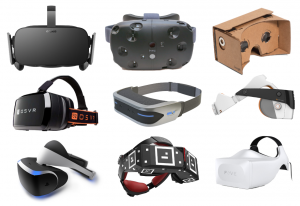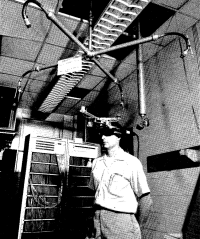Virtual Reality Devices
List of Virtual Reality Devices:
- 3dHEAD GCS3
- Altergaze
- AntVR
- Archos VR
- Avegant Glyph
- Beenoculus
- Cmoar
- Durovis Dive 5
- Durovis Dive 7
- FOVE
- GameFace
- Goggle Tech Go4D C1-Glass
- Goggle Tech Go4D VR
- Google Cardboard
- Homido
- HTC Vive
- Merge VR
- MindLeap
- Oculus Rift
- OSVR
- Project Morpheus
- Samsung Gear VR
- Sensics dSight
- Silicon Micro Display ST1080
- StarVR
- Sting Virtua
- Sulon Cortex
- Virtual Reality Devices
- VisusVR
- VrAse
- Vrvana Totem
- Xingear VR
- XiONVR Go
- Zeiss VR ONE
Virtual Reality Devices are a type of Wearable devices that are worn on the head and display information directly into user's eyes through one or more electronic displays present in the device. Together with Smartglasses and Smart Contact Lenses they create the Head Mounted Displays category. The virtual reality feeling is achieved by splitting the image, or using two displays, of the displayed information in such a way, that a stereoscopic view is created. This creates the feeling of depth in what the user sees and strengthens the immersion of the virtual reality. Additionally, other means of increasing the immersion are often present. These can include sensors to register the position and tilt of the device, which can be then carried over to the virtual reality, headphones to play sound and or music, or eye- and hands-tracking technologies.
Unlike Smartglasses, Virtual Reality Devices are fully enclosed and, with the exception of some hybrid devices combining both, they are not see-through and thus do not combine the actual and virtual realities together. The reality is not altered, but it is completely blocked out instead.
Historical overview
First experiments with devices, that we could call virtual reality devices, begun in the first half of the 20th century. American film-maker and inventor Morton L. Heilig, in pursuing his goal of construction the ultimate Experience Theatre, constructed multimedia device he called The Sensorama.[1] It was a mechanical device capable of displaying a stereoscopic 3D image, playing stereo sound and tilting the user sitting in front of it in dependence with what what happening on the screen. It was also equipped with an aroma dispenser to convey smells of the environment being displayed. Unfortunately, Heilig did not manage to secure funding for his project and The Sensorama remained a prototype only.
While certainly a device capable of virtual reality, The Sensorama was purely mechanical in nature. The true virtual reality machine, one that displays a computer-generated environment, was called The Sword of Damocles.[2] The name was fitting, because the device was quite bulky and had to be attached to a mechanical arm on the ceiling. It was constructed by a computer scientist and computer graphics pioneer Ivan E. Sutherland and his student Bob Sproull in 1968. At that time, they both worked at the Massachusetts Institute of Technology and the experiments with their Head Mounted Display are believed to be the first of the kind. The displayed graphics comprised of simple wire-frame rooms and offered mechanical head tracking.
MIT continued leading the VR research and in 1977 introduced the ARPA funded multimedia system Aspen Movie Map. Essentially an interactive video recorded with four car-mounted cameras, the resulting virtual environment of the Aspen city in Colorado could be navigated in a way similar to Google Street View today. The user could choose an arbitrary path through the virtual city and because Aspen was filmed twice, early fall and winter, the viewer was able to change the season on demand.
The term virtual reality become widespread starting in the 1980 with the creating of VPL Research company which was among the first to develop and also sell virtual reality products. Among the products, the most notable are The Data Glove, a gestural interface device worn on one's hand that would translate the movements of the hand and individual fingers into the virtual environment. The company's second notable product was The EyePhone, a Head Mounted Display capable of head-tracking.
In 1990 and onward, Virtual Reality is advancing faster together with computer technology. The previously expensive and complicated technical solutions are becoming cheaper and possible due to the evolution in computer graphics and performance. VR is no longer confined to military or enterprise applications, it starts expanding into the entertainment industry as well. In 1991, Sega Holdings Co. announces Sega VR, rather unsuccessful head-tracking VR device for arcades. Sega cancelled the development of the home version and took off the arcade models, saying the virtual reality is too real and the users can injure themselves. Dues to the graphical limitations this is highly unlikely, the true reason for the withdrawal was most likely the induced headaches and motion sickness.[3] A similar device, The Virtual Boy by Nintendo Co., entered the marked in 1995. It was marketed as the first portable video console capable of virtual reality. Nintendo anticipated to a great amount of devices but the Virtual Boy was a failure. The marketing campaign was poorly handled and reviews criticised the discomfort the device caused (bad ergonomics, headaches, motion sickness) and wondered about its longevity. The device lacked any head-tracking features which resulted in poor immersion and only a passive 3D experience was achieved. The device did no sell very well and was quietly discontinued in 1996.
The development of VR continued, but only in the of enterprise applications. In 2014, Palmer Luckey introduced the Oculus Rift VR headset. The entrance of Oculus Rift, and other devices that followed, mark a new era in the evolution of virtual reality. The now affordable hardware allows for great performance and thus immersion while the resulting device is still cheap enough a general consumer can afford to buy it. Seeing the success of Oculus, other companies quickly followed with their solutions. They year of 2016, in which most of the VR devices announced in the 2014-2015 are scheduled to be released, will be undoubtedly interesting for the further development of virtual reality.
Summary of technical aspects
A virtual reality device is a type of a Head Mounted Display that is fully enclosed and only displays a computer-generated image. This is achieved by a LED display, or similar, technology. The device is able to display stereoscopic images and thus achieving the illusion of depth. This is managed by using either two separate displays, one for each eye, or by splitting the image in two. Because of this, the image has to be essentially generated twice. With the need of high resolution too, this is a significant performance requirement and also the reason there haven't been affordable consumer application up until the 2015.
The display is combined with optics that help the eyes to focus on a display that is very close and would otherwise be blurry when looked at from such a short distance. Optical techniques also help with the narrow field of view, that has to be considerably big to not cause discomfort to the user (Humans have a field of view up to 180 degrees) and to enhance the immersion factor.
With the exception of smartphone holders, VR devices has to be connected to a computer, because the hardware required to create VR image of suitable quality is still too bulky to fit into a head-mounted unit. Thanks to this, the device needs to be connected to the computer, either via cabling or wirelessly.
Other features include some form of gaze and position tracking. Some of the headsets also feature headphones.
Use
VR devices are used in education, military training, therapy and entertainment.
References
- ↑ Heilig, Morton. "The Cinema of the future." Translated by Uri Feldman. In Multimedia: From Wagner to Virtual Reality. Edited by Randall Packer and Ken Jordan. Expanded ed. New York: WW Norton (2002): 239-251.
- ↑ SUTHERLAND, Ivan E. A head-mounted three dimensional display. In: Proceedings of the December 9-11, 1968, fall joint computer conference, part I. ACM, 1968. p. 757-764.
- ↑ http://web.archive.org/web/20100114191355/http://sega-16.com/feature_page.php?id=5&title=Sega%20VR:%20Great%20Idea%20or%20Wishful%20Thinking?

